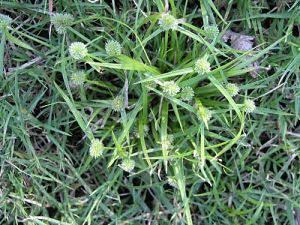Time is Fast Approaching to Control Kyllinga
The time is fast approaching to begin to control kyllinga with properly timed applications of herbicides. Kyllinga is a very troublesome invasive weed species that has moved northward from the south into New Jersey and has begun to take over lawns in recent years. Its’ root system is comprised of an underground system of nodes, called a Rhizome, which allows it to spread laterally beneath the soil. It typically rears its ugly head in mid-May. Warm soil temperatures, consistently 60 degrees or warmer, drive this weed out of its dormancy. It appears in clumps with tiny fuzzy balls at its tips. Left untreated, kyllinga will spread in a mat form and literally take over your existing turf grass. It is very difficult to control once the large mats form.
Ideal conditions for the growth of kyllinga would be lawn areas that receive a lot of sunlight and are poorly drained and/or over irrigated. This weed can be transferred from other lawns using mowers that are not properly maintained and it can just be spread by the wind. However, the number one way the kyllinga gets into lawns is through animal transference. Animals will eat the kyllinga elsewhere and plant it on another lawn through their droppings. Impossible to control this phenomenon. Therefore, it is very important to understand that control is achieved with MULTIPLE applications of an herbicide. Catching the problem early before the kyllinga mats become large, applying an active herbicide correctly, and being persistent are keys to achieving control.
Treatment Options with Green Side Up
For those lawns with known kyllinga issues or those past the management phase there is a treatment option available through Green Side Up. We offer management of existing kyllinga through a two-step (sometimes three-step) process. The first step is to apply a chemical herbicide in the form of a blanket spray that targets and stresses kyllinga and other sedges. The second treatment is applied 3-4 weeks later and will further weaken and kill all stressed kyllinga. These treatments can start as soon as late-May to prevent an outbreak, but treatments are available throughout the summer months.
Depending on the severity of overgrowth and the resilience of the weed, a third treatment may be necessary. Additionally, while this treatment rids turfgrass of current kyllinga infestations, maintaining your lawn after treatments is profoundly important as the key to preventing future outbreaks. It’s amazing how much healthy turf survives after the kyllinga is eliminated. There will be some thinning of the grass. Thickening the lawn through aeration and seeding is a great tool to use and will replenish any damage from kyllinga. It’s also worth looking into installing a drainage system if oversaturation is an issue in your yard. Diligent attention and monitoring is necessary to ensure kyllinga doesn’t creep back into your yard as quickly as we eliminate it. Due to the increased recent findings of kyllinga across local New Jersey yards, Green Side Up anticipates this will become a routine service rendered from year to year.


